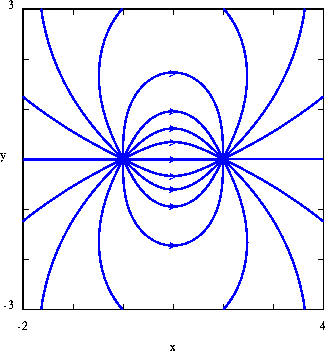Electromagnetic Potentials
Consider two electric charges, one positively charged and the other negatively
charged. Let's put one "unit" of positive charge at the origin and
one unit of negative charge on the x-axis
at the point x=2. The electric potential created by these
two charges is very similar to the gravitational potential that we've studied
in other labs: the electric field is given by the opposite of the
gradient of the potential. The intensity of an electric field may be
pictured by looking at the
intensity of the so-called field lines as shown in Figure 1.

Figure 1: The intensity of an electric field is proportional to
the number of field lines per unit area (perpendicular to the
lines). Thus the field is strong when the field lines are close
together and weak when the field lines are far apart.
Let's start out by investigating the geometry of the electric field.
To begin, let's pretend that the charges live in a 2D world. Then
the electric potential that they generate is
proportional to

Let's begin our study by preparing Maple to
access its linear algebra and special plotting functions:
with(linalg): with(plots):
We can then define V to be the 2D electric potential :
V:= 1/(4*Pi*sqrt(x^2+y^2)) - 1/(4*Pi*sqrt((x-2)^2+y^2));
Question #1
Use the plot3d command to visualize the
electric potential V for x=-0.5..2.5
and y=-1..1. Hint: You may want to
use the option view=-1..1 in order to
better see the essential features of the graph.
To visualize the vector field known as the electric field, issue the command
gradplot( -V, x=-0.5..2.5, y=-1..1, grid=[10,10] );
- Explain how the vector field you see is related to the
graph of the potential function V.
- Describe how the field lines in Figure 1 are related to the electric field.
- Physically, the electric field at the point (x,y)
represents the force that a
small positively-charged "test particle" will feel if placed at
(x,y). Where is the intensity (or magnitude)
of the electric field the strongest?
- Describe the "ultimate fate" of a positively charged particle
placed in this electric field. Where does it go? Does your answer
depend on its initial location?
Next: 3D Flux through a Plane
Previous: Introduction
Robert E. Thurman<thurman@geom.umn.edu>
Document Created: Fri Mar 31 1995
Last modified: Mon Apr 14 11:29:37 1997


